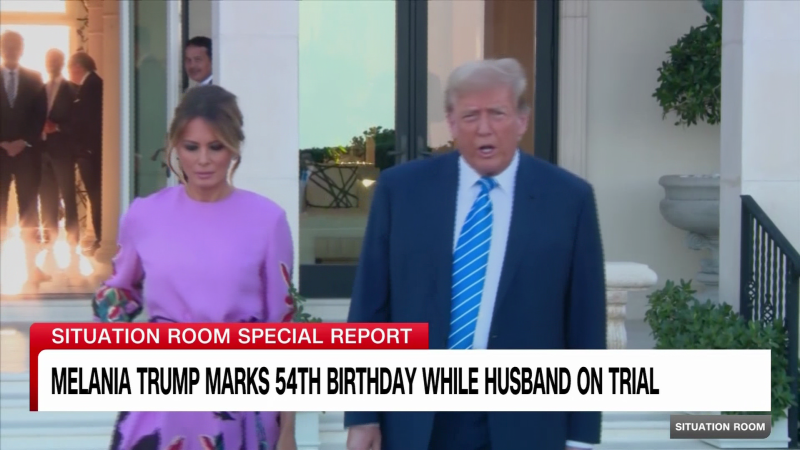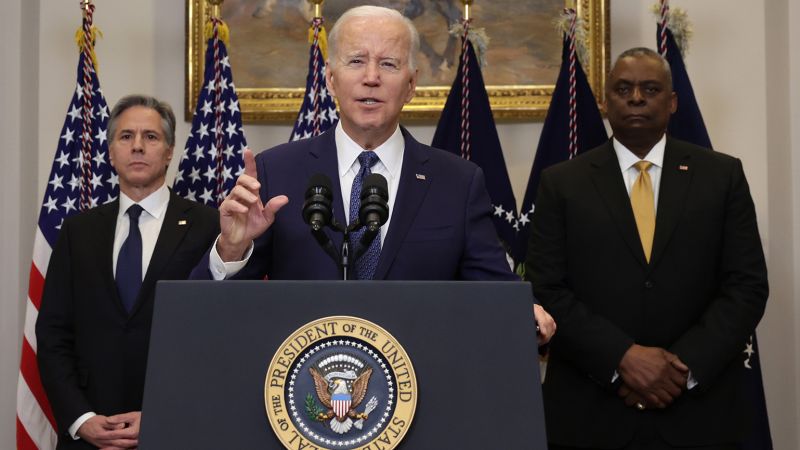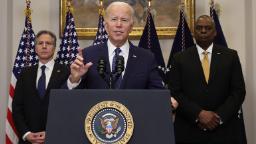CNN
—
The more Russian President Vladimir Putin tries to break NATO, the stronger it gets.
Not for the first time in the war in Ukraine, President Joe Biden took decisive action that closed fissures in the alliance. He announced Wednesday he would ship 31 advanced US tanks to Kyiv’s military in a move that prompted a reluctant Germany to drop its resistance to sending its own tanks and could unlock similar moves all over Europe.
This represented a significant symbolic, political and military win for Ukraine. It hopes what it calls its new “iron fist” will punch through entrenched Russian lines in the east, could fuel an advance on Russia’s land bridge to annexed Crimea in the south and will stave off a feared Russian spring offensive.
It took Biden’s statesmanship to end the most public and damaging Western rift of the war so far. The US had previously said its Abrams tanks were too complex and too high maintenance for the Ukraine war and didn’t suit the terrain. But Biden’s change of heart, which gives Germany cover, underscores Washington’s view that Western unity against Putin is critical to saving Ukraine.
Indeed, Putin’s major goal off the battlefield is to forge splits between the Western allies and to disrupt or end the flow of weapons on which Ukraine’s survival as an independent nation depends.
His failure, despite fierce Russian public threats designed to bully European nations into balking at tank transfers, also comes after a mild winter robbed Russia of another prong of its strategy – starving Europeans of gas imports during freezing weather in hopes they’d pressure their own leaders to step back from supporting Ukraine.
“Putin expected Europe and the United States to weaken our resolve,” Biden said at the White House on Wednesday. “He expected our support for Ukraine to crumble with time. He was wrong … and he was wrong from the beginning and he continues to be wrong. We are united.”
As the first anniversary of the unprovoked Russian invasion approaches, Biden and the West are in an extraordinary position that few strategists would have thought possible a year ago.
— NATO is stronger and more unified than it has been for years. And that is a strategic disaster for Russia. The sense of drift in the alliance early in the 21st century has been driven away by a reminder of the bloc’s founding purpose: a common defense against Moscow’s aggression. Putin’s behavior will ensure that that alliance-nurturing lesson will endure for decades.
— Biden has pinned his legacy on a major land war in Europe in which the United States has engaged in an effective proxy battle with nuclear rival Russia. This fight – which is, in a way, the last battle of the Cold War – is a test of will between an American president and a Kremlin strongman deeply influenced by the US-Soviet standoff. Biden is leading the most significant foreign policy venture at least since the invasion of Iraq in 2003. Its success is critical for America’s credibility as well as his own. The magnitude of the mission is likely to overshadow much of the rest of his presidency – including the current investigation into misplaced classified documents – in world history.
— Biden has restored the US as a strong global leader, reviving its critical transatlantic alliance and steering allies behind the effort with successful and intense diplomacy. And so far, the president’s balancing act – between funneling ever more powerful weaponry to Ukraine and avoiding an escalation with Putin that could lead to a clash with the West or even to Moscow’s use of a smaller scale tactical nuclear weapon – is holding. A dawning second year of war in Ukraine and deepening NATO involvement will test that equation like never before.
— The most remarkable aspect of the evolving relationship between the West and Ukraine is that one of Putin’s presumed motivations for the war was to forestall the possibility that the former Soviet state could join NATO, which would be an even greater humiliation for Moscow than the accession of nations once in Warsaw Pact territory like Poland, Romania and Slovakia. But now, Ukraine’s war effort is being armed and bankrolled by the West, almost as if it is a de-facto NATO state with access to some of the alliance’s most sophisticated weapons systems.
The West’s rationale for that support is also evolving. Once the main goal was to allow a defenseless nation to repel an unprovoked invasion in order for its people to have freedom to choose their political system and sovereignty. Now, the alliance’s leaders seem to see Ukraine as a vital strategic bulwark.
“If President Putin wins, it is a tragedy for Ukrainians, it also dangerous for us,” NATO Secretary General Jens Stoltenberg told CNN’s Kate Bolduan Wednesday, arguing that an authoritarian nation could not be allowed to exert its will and to profit by threats. “It is in our security interest to support the Ukrainians,” he said.
Just because he keeps failing, Putin is unlikely to stop trying to splinter the Western alliance. Hostility toward the US and its allies and a quest for vengeance has been the foundation of his more than two decades in power. And throttling the supply of weapons to Ukraine and fanning Western fatigue with the war remain crucial to his hopes of grinding out victory or avoiding a decisive defeat.
Moscow reacted furiously to the decision on the tanks, calling it extremely dangerous and adding that it took an already bloody conflict to a new level.
Biden, still seeking to avoid any escalation that could lead to a direct clash between NATO and Russian forces, stressed that the new tanks posed no offensive threat to Russia – if only Putin would withdraw his troops from Ukraine. Critics of the war and the massive flow of western arms will become increasingly worried that the West may end up simply fueling a bloody stalemate that will result in the senseless slaughter of thousands of Ukrainian and Russia troops and Ukrainian civilians. Since Moscow and Kyiv both seem to believe they can still win the war, there’s barely any opening for a diplomatic push for a ceasefire or peace.
Western military strategists are, however, warning that Moscow, after an already bloody onslaught, is readying a new offensive for the spring.
“It is dangerous to underestimate Russia,” Stoltenberg said in a speech in Oslo on Wednesday, pointing out that Moscow had mobilized an extra 200,000 troops and was willing to take great risks and endure staggering losses.
Ukraine will now be under pressure to show it can use these new tanks in properly planned combined military operations that maximize their advantages but minimize their weaknesses to make major battlefield gains. While the German tanks, known as the Leopard 2, could arrive within weeks, John Kirby, the National Security Council’s coordinator for strategic communications, told CNN it would be “many months” before the Abrams machines, which still need to be procured from US manufacturers, arrive.
Still, the diplomatic and military chain of consequences unlocked by Biden’s willingness to send the tanks sent an important message to Moscow.
“They are more important as a symbol of US and European commitment,” retired Gen. Wesley Clark, the former NATO Supreme Allied Commander Europe, told CNN’s Wolf Blitzer.
Ukraine had asked for at least 300 tanks. While it remains unclear how many it will receive in the new allied shipments, the total could be around 100. No doubt it hopes that once turned on, the spigot of new armaments will continue flowing. That’s what has consistently happened in the war.
At the time of the invasion last February, the US and its allies were wary of even supplying basic weaponry. But as the brutal war unfolded, and Ukraine inspired the world with its resistance, barriers to more kinetic help fell away. Kyiv is now getting arms, ammunition, drones, Javelin anti-tank missiles, armored vehicles, Patriot anti-missile missiles and now some of the most sophisticated tanks in the US and allied militaries.
When he was in Washington just before Christmas, Ukrainian President Volodymyr Zelensky warned his country’s needs were so great he would never stop asking for more weapons.
So far, the provision of fighter jets – his government’s most cherished request – has been a red line Biden has been unwilling to cross. It is also one that previously caused splits in the alliance.
But the pattern of this war is that what Ukraine asks for, it eventually gets, even if the scale of its requests for specific equipment is not always met.








More News
Paramount Chief Executive Bob Bakish Could Be Out Next Week
Paramedic Avoids Prison in Death of Elijah McClain
For Fox News and Conservative Media, Student Protests Are a Familiar Target